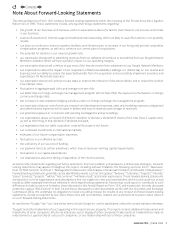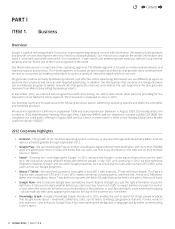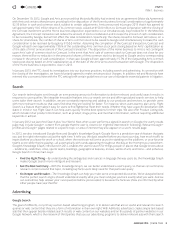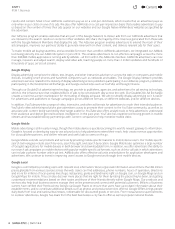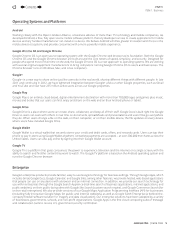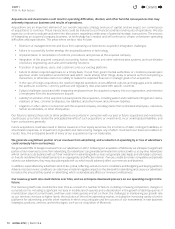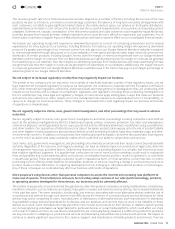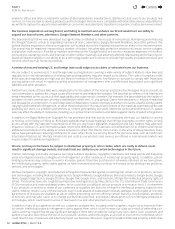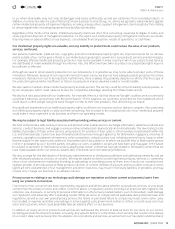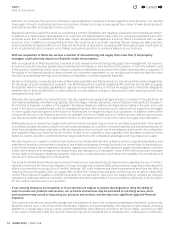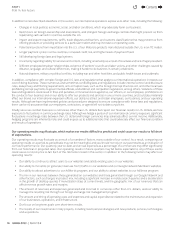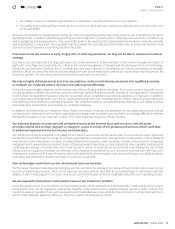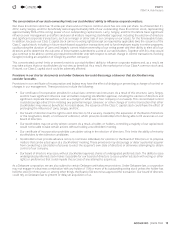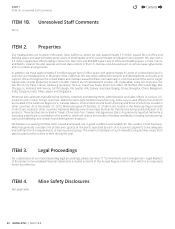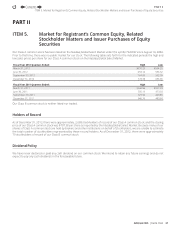Google 2012 Annual Report Download - page 17
Download and view the complete annual report
Please find page 17 of the 2012 Google annual report below. You can navigate through the pages in the report by either clicking on the pages listed below, or by using the keyword search tool below to find specific information within the annual report.
11GOOGLE INC. | Form10-K
PART I
ITEM1A.Risk Factors
The revenue growth rate of our Motorola business will also depend on a number of factors, including the success of the new
products we plan to introduce, our reliance on several large customers, the absence of long-term exclusivity arrangements with
such customers, our ability to gain signifi cant market share in the mobile devices space, our reliance on third-party distributors,
representatives and retailers to sell certain of its products and the successful implementation of our product and operating system
strategies. Furthermore, industry consolidation in the telecommunications and cable industries could negatively impact Motorola’s
business because there would be fewer network operators and it could be more di cult to replace any lost customers. Any of
these factors could have a negative impact on Motorola’s business and have an adverse eff ect on our consolidated fi nancial results.
We believe our operating margin will experience downward pressure as a result of increasing competition and increased
expenditures for many aspects of our business, including Motorola. For instance, our operating margin will experience downward
pressure if a greater percentage of our revenues comes from ads placed on our Google Network Members’ websites compared
to revenues generated through ads placed on our own websites or if we spend a proportionately larger amount to promote the
distribution of certain products, including Google Chrome. Both the margin on revenues we generate from our Google Network
Members and the margin on revenues from our Motorola business are signifi cantly less than the margin on revenues we generate
from advertising on our websites. Also, the margins on advertising revenues from mobile devices and newer advertising formats
are generally less than the margin on revenues we generate from advertising on our websites. Additionally, the margin we earn
on revenues generated from our Google Network Members could decrease in the future if we pay an even larger percentage of
advertising fees to our Google Network Members.
We are subject to increased regulatory scrutiny that may negatively impact our business.
The growth of our company and our expansion into a variety of new fi elds implicate a variety of new regulatory issues, and we
have experienced increased regulatory scrutiny as we have grown. We continue to cooperate with the European Commission
(EC), other international regulatory authorities, and several state attorneys general in investigations they are conducting with
respect to our business and its impact on competition. Legislators and regulators, including those conducting investigations in
the U.S. and Europe, may make legal and regulatory changes, or interpret and apply existing laws, in ways that make our products
and services less useful to our users, require us to incur substantial costs, expose us to unanticipated civil or criminal liability, or
cause us to change our business practices. These changes or increased costs could negatively impact our business and results
of operations in material ways.
We are regularly subject to claims, suits, government investigations, and other proceedings that may result in adverse
outcomes.
We are regularly subject to claims, suits, government investigations, and other proceedings involving competition and antitrust
(such as the pending investigations by the EC), intellectual property, privacy, consumer protection, tax, labor and employment,
commercial disputes, content generated by our users, goods and services off ered by advertisers or publishers using our platforms,
and other matters. Our acquisition of Motorola and our sale of hardware products also expose us to the risk of product liability
and other litigation involving assertions about product defects, as well as health and safety, hazardous materials usage, and other
environmental concerns. In addition, our businesses face intellectual property litigation, as further discussed later, that exposes
us to the risk of exclusion and cease and desist orders, which could limit our ability to sell products and services.
Such claims, suits, government investigations, and proceedings are inherently uncertain and their results cannot be predicted with
certainty. Regardless of the outcome, such legal proceedings can have an adverse impact on us because of legal costs, diversion
of management resources, and other factors. Determining reserves for our pending litigation is a complex, fact-intensive process
that requires signifi cant judgment. It is possible that a resolution of one or more such proceedings could result in substantial
fi nes and penalties that could adversely aff ect our business, consolidated fi nancial position, results of operations, or cash fl ows
in a particular period. These proceedings could also result in reputational harm, criminal sanctions, consent decrees, or orders
preventing us from off ering certain features, functionalities, products, or services, requiring a change in our business practices or
product recalls or other fi eld action, or requiring development of non-infringing or otherwise altered products or technologies.
Any of these consequences could adversely aff ect our business and results of operations.
More people are using devices other than personal computers to access the internet and accessing new platforms to
make search queries. If manufacturers and users do not widely adopt versions of our web search technology, products,
or operating systems developed for these devices, our business could be adversely aff ected.
The number of people who access the internet through devices other than personal computers, including mobile phones, smartphones,
handheld computers such as netbooks and tablets, video game consoles, and television set-top devices, has increased dramatically
in the past few years. The lower resolution, functionality, and memory associated with some alternative devices make the use of
our products and services through such devices more di cult and the versions of our products and services developed for these
devices may not be compelling to users, manufacturers, or distributors of alternative devices. Each manufacturer or distributor
may establish unique technical standards for its devices, and our products and services may not work or be viewable on these
devices as a result. Some manufacturers may also elect not to include our products on their devices. In addition, search queries
are increasingly being undertaken via “apps” tailored to particular devices or social media platforms, which could aff ect our share
of the search market over time. As new devices and platforms are continually being released, it is di cult to predict the problems
we may encounter in adapting our products and services and developing competitive new products and services. We expect to
continue to devote signifi cant resources to the creation, support, and maintenance of mobile products and services. If we are
4
Contents
4


